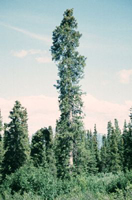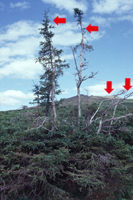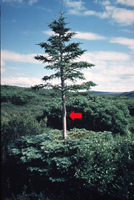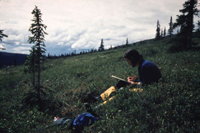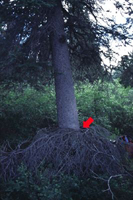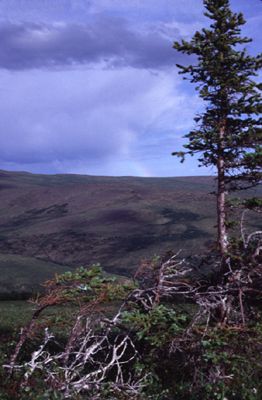|
|
|||||||||||||||||
|
|||||||||||||||||
1) Different Tree Growth Forms
|
|||||||||||||||||
|
Some trees grow straight
and tall. Each year, the tree produces buds that develop into
new branches and leaves. A stem called the "leader" grows up
above the rest and, therefore, the tree keeps its upright form.
How does this happen? Something called "apical dominance" happens.
Click
here to learn more.
|
Other trees are not straight
and tall; some grow as twisted "krummholz" forms. Krummholz
trees often have more than one leader, like in the picture above
(the red arrows).Why is there more than one leader? The "apical
dominance" fails when the apical buds are killed. Often times,
blowing ice crystals kill apical buds... Click
here to learn more about apical dominance.
|
|
...And these buds tend
to die at a certain point in the tree's vertical growth. Notice
how this tree is "flagged"-- it has a section of stem that has
little or no branches. This branchless region (red arrow) is
where the snowpack is: everything underneath it hides under
the snow during harsh winter winds, while just above the snow,
the harshest winds blow into the apical bud.
|
So once a tree gets up
above this snowpack region (during a few years that are not
as harsh), it can usually grow straight again. Notice how these
leaders grow straight, yet come from a base that is twisted
because of many apical deaths.
|
2) What did we do?
|
So what did we do? We
classified and documented each tree's growth form (or morphology)
in order to learn about conditions at and above treeline.
|
Since we also want to know
what a tree has grown like in the past, we look for signs of
that, too. This tree, for instance, shows a "skirt"-- an area
that used to be twisted krummholz (see red arrow). Even though
the tree appears straight and is growing well now, the skirt
suggests that growing conditions were once challenging for this
tree. It probably had a hard time getting above the snowpack.
We record these clues of the past when we classify each tree's
growth form.
|
3) What did we find?
|
In summary, we record
what the tree looks like so that we can reconstruct what the
growing conditions may have been like for the past several hundred
years. Is there more than one leader? Is the tree a twisted
krummholz or straight? What did it look like 50 years ago? We
are particularly interested in how these growth forms have changed
over time. Take the tree above, for instance: new leaders have
quickly grown up from an old, twisted krummholz base. (How
do we know it's old? Click here to find out.) This suggests
that conditions have ameliorated-- that they are more favorable
for growth. So what the trees look like may be clues to what
the climate has been like in the past.
|
Graphs like this one compare
growth form over time. Click here
to see a bigger graph and learn more. From the the growth
forms we have looked at so far and the graphs we have made with
that information, it appears that growth form might be changing
over time. In recent times (around 1960), trees have been growing
more upright than in the past (from 1700 to 1960). This is interesting
because the climate in the area has also gotten warmer during
this time. Click here to see climate data.
|
A word of caution:
Growth form is determined by what conditions a tree grows in (wind, cold temperatures, etc.). Because these conditions are usually different between treeline and above treeline, there are often more krummholz trees above treeline-- conditions tend to be harsher. But even though there are more krummholz trees above treeline, there are fewer trees total because the harsher conditions above prevent as many trees from establishing.
All Rights Reserved (R) Middlebury College Biology, 1999, 2000

